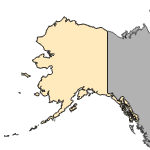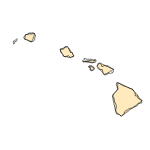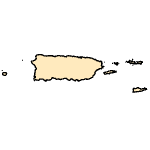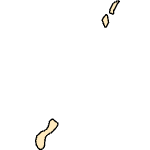Pisidium supinum
(humpbacked peaclam)
Mollusks-Bivalves
Exotic |
|
Common name: humpbacked peaclam
Synonyms and Other Names: humpback/hump-backed pea/pill clam, pisidiid clam
Taxonomy: available through
www.itis.gov
Identification: This triangular, somewhat inflated bivalve has a height to length ratio of approximately 0.9. The shell displays distinct beaks with an oblique ridge, thick hinge teeth, and cardinal teeth that are relatively far from the anterior denticles. The dorsal side of the shell is very short and rounded, the anterior side is straight and long but starts to round ventrally, and the posterior side is relatively blunt. There are around 16–18 striae per mm on the shell surface (Clarke 1981, Mackie 2000).
Size: can grow to around 4.5 mm in length (Clarke 1981, Mackie 2000).
Native Range: Pisidium supinum is native to Eurasia, including Iceland (Clarke 1981).



|

Alaska |

Hawaii |

Puerto Rico &
Virgin Islands |

Guam Saipan |
Hydrologic Unit Codes (HUCs) Explained
Interactive maps: Point Distribution Maps
Nonindigenous Occurrences:
Table 1. States with nonindigenous occurrences, the earliest and latest observations in each state, and the tally and names of HUCs with observations†. Names and dates are hyperlinked to their relevant specimen records. The list of references for all nonindigenous occurrences of Pisidium supinum are found here.
Table last updated 12/15/2025
† Populations may not be currently present.
Ecology: Pisidium supinum is generally rheophilic, preferring lotic waters in canals and rivers, although it can tolerate more lentic waters in lakes. It is usually found in coarse sand, silty sand, or mud. In North America P. supinum is much more common in the Ottawa River and the St. Lawrence River than the Great Lakes. It is very sensitive to eutrophication but is resilient to both low waters and floods in the River Issel, Netherlands, where it can reach densities of 24,000 individuals per m2 (Bishop and Hewitt 1976, Extence et al. 1999, Hinz et al. 1982, Mackie 2000, Mouthon 1996, Piechocki and Strzelec 1999, Reckendorfer et al. 2006, Smit et al. 1994, 1995, Zettler 1996).
Pisidium supinum filter feeds on planktonic algae and specifically prefers diatoms. It filters suspended material from the water column mostly via movements of its foot and cilia but can directly ingest deposits from the sediments as well (Lopez and Holopainen 1987, Mackie 2000).
Pisidium spp. are hermaphrodites and ovoviviparous with relatively low reproductive output. They produce a few young per brood and around one or two broods per year (Boycott 1936).
Means of Introduction: Pisidium supinum was probably introduced by the shipping industry, likely via solid ballast, which was in use at the turn of the century (Grigorovich et al. 2000).
Status: Established where recorded.
Impact of Introduction: The impacts of this species are currently unknown, as no studies have been done to determine how it has affected ecosystems in the invaded range. The absence of data does not equate to lack of effects. It does, however, mean that research is required to evaluate effects before conclusions can be made.
References: (click for full references)
Bishop, M.J., and S.J. Hewitt. 1976. Assemblages of
Pisidium spp. (Bivalvia: Sphaeriidae) from localities in eastern England. Freshwater Biology 6(2):177-182.
Boycott, A.E. 1936. The habitats of fresh-water Mollusca in Britain. The Journal of Animal Ecology 5(1):116-186.
Clarke, A.H. 1981. French translation by A. La Rocque. Les Mollusques d’eau douce du Canada. Musée national des sciences naturelles, Musées nationaux du Canada. 447 pp.
Corkum, L.D. 2000. Section 11.2 Non-indigenous invasive species in Lake Erie. Pp. 1-13 in Lake Erie Lakewide Management Plan, Lake Erie LaMP Work Group, Environment Canada and the U. S. Environmental Protection Agency.
Extence, C.A., D.M. Balbi, and R.P. Chadd. 1999. River flow indexing using British benthic macroinvertebrates: a framework for setting hydroecological objectives. Regulated Rivers: Research and Management 15:543-574.
Grigorovich, I.A., A.V. Korniushin, and H.J. MacIsaac. 2000. Moitessier’s pea clam Pisidium moitessierianum (Bivalvia, Sphaeriidae): a cryptogenic mollusk in the Great Lakes. Hydrobiologia 435:153-165.
Grigorovich, I.A., R.I. Colautti, E.L. Mills, K. Holeck, A.G. Ballert, and H.J. MacIsaac. 2003. Ballast-mediated animal introductions in the Laurentian Great Lakes: retrospective and prospective analysis. Canadian Journal of Fisheries and Aquatic Sciences 60:740-756.
Herrington, H.B. 1962. A revision of the Sphaeriidae of North America (Mollusca: Pelecypoda). Museum of Zoology, University of Michigan, Miscellaneous Publications 118. 74 pp 7 plates.
Hinz, W., H. Daub, C. Marx, C. Tinz, and W. Wiersch. 1982. The mollusk fauna of the Issel system at the time of the1976-1977 expansion. Decheniana. Bonn. 134:176-177.
Johnson, M.G., and D.H. Matheson. 1968. Macroinvertebrate communities of the sediments of Hamilton Bay and adjacent Lake Ontario. Limnology and Oceanography 13(1):99-111.
Lopez G.R., and I.J. Holopainen. 1987. Interstitial suspension-feeding by Pisidium spp. (Pisidiidae: Bivalvia): A new guild in the lentic benthos? American Malacological Bulletin 5:21–30.
MacIsaac, H.J. 1999. Biological invasions in Lake Erie: past, present and future. Pp. 305-322 in M. Munawar and T. Edsall, eds. State of Lake Erie (SOLE) - past, present and future. Ecovision World Monograph Series, Backhuys, Leiden, The Netherlands. 550 pp.
Mackie, G.L. 2000. Ballast water introductions of Mollusca. Pp. 219-254 in R. Claudi and J. H. Leach, eds. Nonindigenous Freshwater Organisms: Vectors, Biology and Impacts. CRC Press LLC, Boca Raton, Florida. 464 pp.
Mouthon, J. 1996. Molluscs and biodegradable pollution in rivers: proposal for a scale of sensitivity of species. Hydrobiologia 317:221-229.
Piechocki, A., and M. Strzelec. 1999. Ecology of Sphaeriidae (Bivalvia: Heterodonta) in sandy bottom sections of the Grabia River (C-Poland). Malacological Review Supplement 8:37-58.
Quinn, R.M., K.J. Gaston, and H.R. Arnold. 1996. Relative measures of geographic range size: empirical comparisons. Oecologia 107:179-188.
Reckendorfer, W., C. Baranyi, A. Funk, and F. Schiemer. 2006. Floodplain restoration by reinforcing hydrological connectivity: expected effects on aquatic mollusc communities. Journal of Applied Ecology 43(3):474-484.
Smit, H., H.C. Reinhold-Dudok Van Heel, and S.M. Wiersma. 1995. Sublittoral macrozoobenthic assemblages in the enclosed sediment-polluted Rhine-Meuse Delta; their relationship to environmental conditions. Netherlands Journal of Aquatic Ecology 29(1):31-47.
Smit, H., J.A. Van Der Velden, and A. Klink. 1994. Macrozoobenthic assemblages in littoral sediments in the enclosed Rhine-Meuse Delta. Netherlands Journal of Aquatic Ecology 28(2):199-212.
US Army Corp of Engineers (USACE). 2012. Molluscicides. Accessed 10/28/13. http://glmris.anl.gov/documents/docs/anscontrol/Molluscicides.pdf
Zettler, M. 1996. The aquatic malacofauna (Gastropoda et Bivalvia) in the catchment area of a north German lowland river, the Warnow. Limnologica 26(3):327-337.
Author:
Kipp, R.M., J. Larson, and A. Fusaro
Revision Date: 11/26/2019
Citation Information:
Kipp, R.M., J. Larson, and A. Fusaro, 2025, Pisidium supinum Schmidt 1850: U.S. Geological Survey, Nonindigenous Aquatic Species Database, Gainesville, FL, https://nas.er.usgs.gov/queries/FactSheet.aspx?SpeciesID=2391, Revision Date: 11/26/2019, Access Date: 12/15/2025
This information is preliminary or provisional and is subject to revision. It is being provided to meet the need for timely best science. The information has not received final approval by the U.S. Geological Survey (USGS) and is provided on the condition that neither the USGS nor the U.S. Government shall be held liable for any damages resulting from the authorized or unauthorized use of the information.